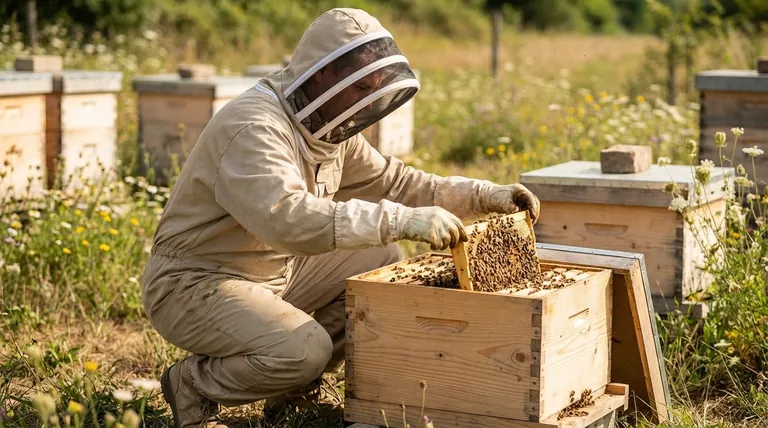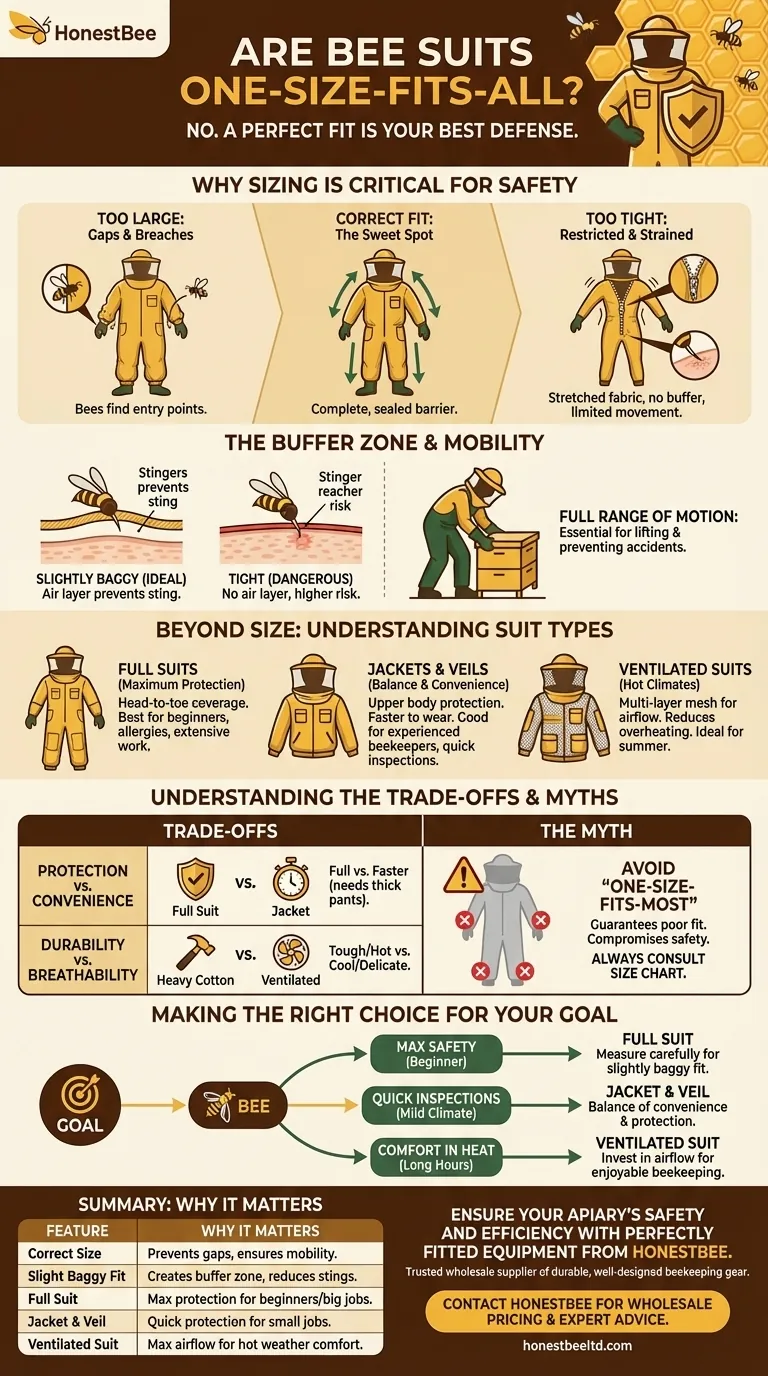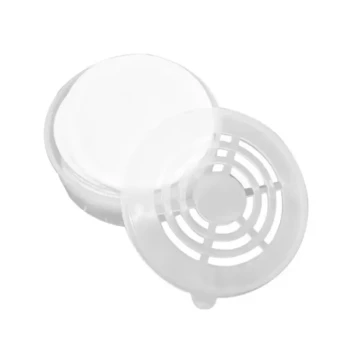Contrary to what some may assume, bee suits are not one-size-fits-all. They are available in a range of specific sizes, much like regular clothing. Obtaining the correct size is the single most important factor for ensuring both your safety from stings and your comfort while working with your hives.
A bee suit is your primary line of defense. Choosing one is not just about covering your skin; it's about selecting the right tool for the job, where an improper fit can transform a protective garment into a safety liability.

Why Sizing is Critical for Safety
A bee suit that doesn't fit correctly fails at its fundamental purpose. The goal is to create a complete, sealed barrier between you and the bees.
Preventing Gaps and Breaches
A suit that is too large can create gaps. Bees are experts at finding small openings, and loose cuffs at the wrists or ankles are common entry points.
Conversely, a suit that is too tight stretches the material. This tension can pull zippers apart or create stress points that may tear over time.
Ensuring Full Range of Motion
Beekeeping requires you to bend, lift heavy boxes, and move with care. A suit that is too small will restrict your movement, making you clumsy and uncomfortable.
This lack of mobility is not just an annoyance; it can be dangerous if it causes you to drop a frame of bees or lose your balance.
Creating a Buffer Zone
The ideal bee suit should be slightly baggy. This creates a crucial layer of air between the fabric and your skin.
If a bee does land on you and attempts to sting, the loose material means its stinger is less likely to be long enough to reach your skin. A tight suit eliminates this buffer zone entirely.
Beyond Size: Understanding Bee Suit Types
Once you have determined your size, the next consideration is the style of the suit. Each type serves a different purpose.
Full Suits
A full suit is a one-piece garment that covers you from head to toe. It offers the most comprehensive protection by minimizing potential entry points for bees.
This is the recommended choice for beginners, individuals with known bee sting allergies, or anyone performing extensive hive work.
Jackets and Veils
A beekeeping jacket provides protection for your upper body, arms, and head. It's faster to put on and take off than a full suit.
This option is popular with experienced beekeepers for quick inspections, as it offers a good balance between safety and convenience.
Ventilated Suits
Ventilated suits are a modern design for beekeeping in hot climates. They are constructed with layers of mesh fabric that allow for significant airflow.
While they are typically more expensive, they drastically improve comfort and reduce the risk of overheating during long work sessions in the summer.
Understanding the Trade-offs
Every equipment choice in beekeeping involves balancing different factors. Bee suits are no exception.
Protection vs. Convenience
A full suit offers maximum protection but is heavier and takes longer to get into. A jacket is more convenient but leaves your lower body exposed, requiring you to wear thick pants.
Durability vs. Breathability
Traditional, heavy cotton suits are extremely durable but can be very hot. Lighter poly-cotton blends and fully ventilated suits are far more comfortable but may be more susceptible to snags and tears.
The "One-Size-Fits-Most" Myth
Some low-cost options are marketed as "one-size-fits-most." Avoid these. This approach almost guarantees a poor fit for most people, compromising the suit's protective integrity at the wrists, ankles, and neck. Always consult a manufacturer's specific size chart.
Making the Right Choice for Your Goal
Your ideal suit depends on your climate, beekeeping intensity, and personal comfort.
- If your primary focus is maximum safety as a beginner: Opt for a slightly baggy, full-body suit and carefully measure yourself against the manufacturer's size chart.
- If your primary focus is quick inspections in a mild climate: A high-quality beekeeping jacket with a built-in veil offers an excellent balance of convenience and protection.
- If your primary focus is comfort during long hours in the heat: Invest in a ventilated suit, as the improved airflow will make your beekeeping experience vastly more enjoyable.
Ultimately, choosing the right bee suit is an investment in your ability to work confidently and safely with your colonies.
Summary Table:
| Feature | Why It Matters |
|---|---|
| Correct Size | Prevents gaps for bees to enter and avoids restrictive movement. |
| Slight Baggy Fit | Creates a buffer zone so stingers are less likely to reach your skin. |
| Full Suit | Offers maximum protection, ideal for beginners or extensive work. |
| Jacket & Veil | Provides a balance of protection and convenience for quick inspections. |
| Ventilated Suit | Maximizes airflow and comfort for beekeeping in hot climates. |
Ensure your apiary's safety and efficiency with perfectly fitted equipment from HONESTBEE.
As a trusted wholesale supplier to commercial apiaries and distributors, we understand that the right gear is non-negotiable for productivity and protection. Our range of durable, well-designed bee suits and beekeeping equipment is built to meet the rigorous demands of professional beekeeping.
Let us help you equip your team with reliable gear that fits correctly and performs flawlessly.
Contact HONESTBEE today for wholesale pricing and expert advice on the best equipment for your operation.
Visual Guide

Related Products
- Wholesales Dadant Size Wooden Bee Hives for Beekeeping
- Yellow Plastic Bucket Pail Perch for Beekeeping
- Long Langstroth Style Horizontal Top Bar Hive for Wholesale
- Professional Insulated Winter Hive Wrap for Beekeeping
- Automatic Honey Flow Beehive 4 Frame Mini Hive for Beekeeping
People Also Ask
- What are the characteristics of oil-based paint for beehives? Durability vs. Modern Practicality
- How often should the area under beehives be inspected and cleaned during the warm season? A Proactive Maintenance Guide
- What are the advantages of wooden bee hives? Superior Bee Health & Beekeeper Flexibility
- What are the essential pieces of equipment for most beekeepers? Get Started with the Right Gear
- What should you do if you find an ant nest near your beehive? Essential Strategies for Hive Protection



















